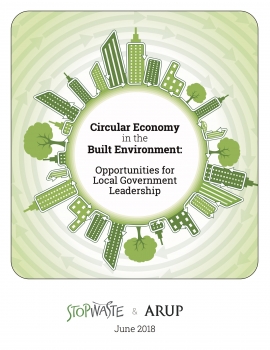Codes, Standards & Labels
Green labels, codes and standards drive energy and water savings, reduce waste and greenhouse gas emissions, and lead to healthier, more resilient communities.
CALGreen Building Code Update - May 2024
On July 1, 2024, a series of updates to California's green building code goes into effect. StopWaste has put together several resources for building department staff who will be responsible for enforcing these new codes. Additional details are available here.
Multifamily Buildings
In California, there are more than 3 million multifamily buildings, accounting for approximately 24% of residential energy use and about 11% of all building energy use in the state. Over 70% of these buildings were constructed prior to 1978, before there were efficiency standards.
Energy and water efficiency improvements in these buildings can provide significant cost savings for renters and property owners, and can help municipalities meet their greenhouse gas reduction goals.
Energy & Materials
In the United States, buildings account for approximately one third of raw material use, total energy use, greenhouse gas emissions, and waste generation, as well as 12% of potable water consumption.
As part of StopWaste's mission to increase recycling and reduce waste in Alameda County, we develop innovative solutions to address the environmental impacts of the building sector.
Our priorities include:
Built Environment
StopWaste partners with local governments in Alameda County to advance innovative solutions that increase recycling and reduce waste related to buildings and landscapes.
We provide policy, regulatory and technical support focusing on these areas:
C&D Hazardous Waste and Materials
You may encounter hazardous waste and materials at construction sites on a regular basis. The materials listed below CANNOT be recycled using curbside recycling or placed in the trash, rather they must be recycled by a specialty recycler.
For a listing of recycling facilities in the Bay Area that properly handle hazardous waste materials, click on the links below:
BMRA Model Guide Specification: Deconstruction of Buildings
The purpose of this Model Guide Specification is to provide the building industry with a consistent set of technical requirements for deconstructing buildings as the Owner’s directed method of building removal, based on the best knowledge and practices available within the industry.
BMRA Model Guide Specification: Section 02 42 13.13 Deconstruction of Buildings
Built Environment Services for Member Agencies
Related Resources
 Read More
Read MoreAuthored by StopWaste and Arup, this primer provides an overview of a circular economy framework for the built environment at the community, neighborhood and building scales. The ideas and concepts included here are intended to stimulate local government decision-makers and staff in Alameda County and beyond to consider policies and actions in their jurisdictions.
Construction & Demolition Recycling Working Group Presentation Jan-2016
On January 22, 2016, StopWaste hosted our Alameda County C&D Working Group to discuss recent updates and pending changes to the C&D industry. Topics included the new CALGreen 2016 code changes that require 65% C&D diversion statewide (as of January 1, 2017), updating local C&D ordinances, and efforts around regional coordination of C&D facility diversion rates.
Space Guidelines for Recycling, Organics and Refuse Services
This document provides guidelines to help designers of multifamily, commercial and mixed-use buildings plan for recycling collection when designing new buildings or major renovations.
